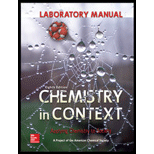
Concept explainers
(a)
Interpretation:
Which types of batteries are commonly recycled have to be found.
Concept introduction:
Primary battery: Primary batteries are irreversible transform chemical energy to electrical energy. When the initial supply of reactants is exhausted, energy cannot be readily restored to the battery by electrical means.
Secondary battery: This can be recharged, that is they can have their
(b)
Interpretation:
The
Concept introduction:
Electrochemical cell is a device capable of converting chemical energy into electrical energy or induces chemical energy by electrical energy. In the galvanic cell spontaneous redox reaction takes place. Redox reaction means the reaction in which the oxidation state of the atoms changes due to the occurrence of both reduction and its complementary oxidation reactions. The element under oxidation reaction loses electron whereas the element in the reduction gains electron.
Primary battery: Primary batteries are irreversible transform chemical energy to electrical energy. When the initial supply of reactants is exhausted, energy cannot be readily restored to the battery by electrical means.
Secondary battery: This can be recharged, that is they can have their chemical reaction reversed by supplying electrical energy to the cell restoring their original composition.
(c)
Interpretation:
Household battery recycling programs have not been as effective as those for recycling car batteries and list some reasons should be provided.
Concept introduction:
Electrochemical cell is a device capable of converting chemical energy into electrical energy or induces chemical energy by electrical energy. In the galvanic cell spontaneous redox reaction takes place. Redox reaction means the reaction in which the oxidation state of the atoms changes due to the occurrence of both reduction and its complementary oxidation reactions. The element under oxidation reaction loses electron whereas the element in the reduction gains electron.
Primary battery: Primary batteries are irreversible transform chemical energy to electrical energy. When the initial supply of reactants is exhausted, energy cannot be readily restored to the battery by electrical means.
Secondary battery: This can be recharged, that is they can have their chemical reaction reversed by supplying electrical energy to the cell restoring their original composition.
Want to see the full answer?
Check out a sample textbook solution
Chapter 8 Solutions
Laboratory Manual Chemistry in Context
- Predict the major products of this organic reaction. Be sure you use dash and wedge bonds to show stereochemistry where it's important. + ☑ OH 1. TsCl, py .... 文 P 2. t-BuO K Click and drag to start drawing a structure.arrow_forwardConsider this organic reaction: ( Draw the major products of the reaction in the drawing area below. If there won't be any major products, because this reaction won't happen at a significant rate, check the box under the drawing area instead. Click and drag to start drawing a structure. Х : а ค 1arrow_forwardIn the drawing area below, draw the major products of this organic reaction: If there are no major products, because nothing much will happen to the reactant under these reaction conditions, check the box under the drawing area instead. 1. NaH 2. CH3Br ? Click and drag to start drawing a structure. No reaction. : ☐ Narrow_forward
- + Predict the major product of the following reaction. : ☐ + ☑ ค OH H₂SO4 Click and drag to start drawing a structure.arrow_forwardConsider this organic reaction: ... OH CI Draw the major products of the reaction in the drawing area below. If there won't be any major products, because this reaction won't happen at a significant rate, check the box under the drawing area instead. ☐ No Reaction. Click and drag to start drawing a structure. : аarrow_forwardConsider the following reactants: Br Would elimination take place at a significant rate between these reactants? Note for advanced students: by significant, we mean that the rate of elimination would be greater than the rate of competing substitution reactions. yes O no If you said elimination would take place, draw the major products in the upper drawing area. If you said elimination would take place, also draw the complete mechanism for one of the major products in the lower drawing area. If there is more than one major product, you may draw the mechanism that leads to any of them. Major Products:arrow_forward
- Draw one product of an elimination reaction between the molecules below. Note: There may be several correct answers. You only need to draw one of them. You do not need to draw any of the side products of the reaction. OH + ! : ☐ + Х Click and drag to start drawing a structure.arrow_forwardFind one pertinent analytical procedure for each of following questions relating to food safety analysis. Question 1: The presence of lead, mercury and cadmium in canned tuna Question 2: Correct use of food labellingarrow_forwardFormulate TWO key questions that are are specifically in relation to food safety. In addition to this, convert these questions into a requirement for chemical analysis.arrow_forward
- What are the retrosynthesis and forward synthesis of these reactions?arrow_forwardWhich of the given reactions would form meso product? H₂O, H2SO4 III m CH3 CH₂ONa CH3OH || H₂O, H2SO4 CH3 1. LiAlH4, THF 2. H₂O CH3 IVarrow_forwardWhat is the major product of the following reaction? O IV III HCI D = III ა IVarrow_forward
 General Chemistry - Standalone book (MindTap Cour...ChemistryISBN:9781305580343Author:Steven D. Gammon, Ebbing, Darrell Ebbing, Steven D., Darrell; Gammon, Darrell Ebbing; Steven D. Gammon, Darrell D.; Gammon, Ebbing; Steven D. Gammon; DarrellPublisher:Cengage Learning
General Chemistry - Standalone book (MindTap Cour...ChemistryISBN:9781305580343Author:Steven D. Gammon, Ebbing, Darrell Ebbing, Steven D., Darrell; Gammon, Darrell Ebbing; Steven D. Gammon, Darrell D.; Gammon, Ebbing; Steven D. Gammon; DarrellPublisher:Cengage Learning
